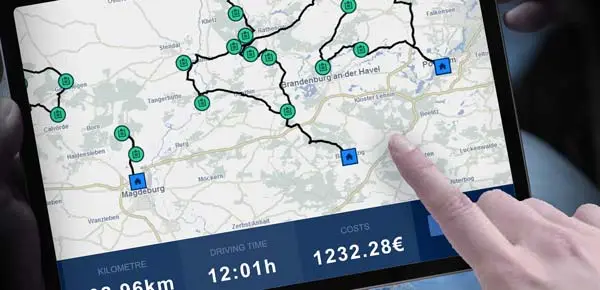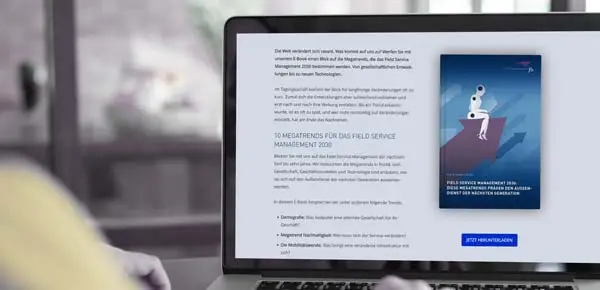
BLOG / MEDIA · CO2 REDUCTION
7 WAYS FIELD SERVICE MANAGERS CAN CUT CO2
8 April 2021 · Jeremy Squire
We've pulled together some ideas restart your plan, and help the environment without hurting your business.
TIP 1
RENEWABLE ENERGY ACROSS YOUR ESTATE
Renewable energy sources are much easier to identify today. Installing solar panels on your warehousing and offices can be one solution. But before companies (or their landlords) make any major investments, it's advisable to engage with your electricity provider. Do you know if your electricity provider uses renewable resources? Their website is likely to tell you, either through FAQs, or your account manager. Switching is less complicated than you think and a fairly painless way for your company to save on CO2 emissions. If you are connected to an existing electricity grid and do not have the option to switch, you can also offset the CO2 you produce through purchasing tokens. This is also a good option to offset CO2 emissions of your field force.TIP 2
OPTIMISE YOUR ENERGY EFFICIENCY
What about your energy efficiency? Here, too, you can easily change something and thus achieve CO2 savings. Did you know that LED luminaires last longer than halogen lamps, emit the same power of brightness, but consume a full 85% less electricity? So not only can you do the environment a favour, you can also save money. What's more, nowadays there is an energy-saving alternative for all electronic devices, like a laptop instead of desktop PC. The options are many and you could even send some bulbs to your employees.TIP 3
FINALLY GO PAPERLESS
Digitalisation can also help the environment. Namely, by going completely digital with your business and banning paper from your operations. This also saves space and resources. An extra result is data stored in the cloud is less likely to get lost than pieces of paper and can be accessed from anywhere. Digital document management is particularly helpful for your field staff. This means that all the data required for a job is always up to date and can be accessed via an app, for example.TIP 4
THE TRAIN INSTEAD OF THE INTERNAL FLIGHT
In the age of video conferencing, domestic flights for business trips are being scrutinised particularly critically. Understandably so, because the potential for CO2 savings is huge. Of course, companies cannot and should not do without business travel. The train, for example, is an often unjustly disdained alternative. Thanks to WLAN on board, and mobile hotspots, train travel offers your employees a strong opportunity to make good use of the journey time.TIP 5
COOPERATION WITH CO2-NEUTRAL SUPPLIERS AND SERVICE PROVIDERS
Another way to reduce your company's CO2 emissions is to check your service providers and suppliers. Find out whether these companies are already working in a CO2-neutral way or check out sensible alternatives for your chain.TIP 6
MORE HOME OFFICE
Even with a 'COVID safe' setting, will you allow your head office employees the option to work remotely? You're missing a great potential for CO2 savings. Offer your employees the option of a home office and you'll save heating and lighting a large office space. You also won't be receiving so many deliveries (water for water coolers, print supplies etc.) Does your field force really need to visit the office first? Your employees will save on commuting and will also be happy about the new flexibility they have gained.TIP 7
REDUCE THE KILOMETRES TRAVELLED BY YOUR FIELD STAFF
Field service is usually one of the first points mentioned when thinking about the CO2 emissions of companies. But here, too, there is great potential for optimisation. Simply reducing the kilometres driven by your field service fleet can lead to massive CO2 savings. By using real-time route planning software, for example, your field staff can achieve kilometre savings of up to 52% per job or appointment. This corresponds to approximately 900,000 kg CO2 per year.SUSTAINABLE EFFECTS THROUGH ISO CERTIFICATION
The implementation of measures to reduce CO2 emissions is an important step for companies in order to protect the environment and conserve resources. However, the intention to tackle and change things often collides with the practical implementation. Committing to environmental management and being measured against fixed standards is definitely the right step to strengthen your company's sustainable actions. One way is to have your environmental management certified according to ISO 14001.On the way to certification, you can also benefit from suggestions for improvement from independent auditors. Of course, environmental management certification is also an excellent advertisement for your company. If you think back to the selection of CO2-neutral service providers, this has another undeniable added value.

JEREMY SQUIRE
UK Managing Director
Call +44 1183 800189
Send email ›
Jeremy Squire is a business leader and solutions consultant with over 20 years experience in field service scheduling and route optimisation software solutions. He is one of Europe's most recognised and regarded voices in field service technology.




